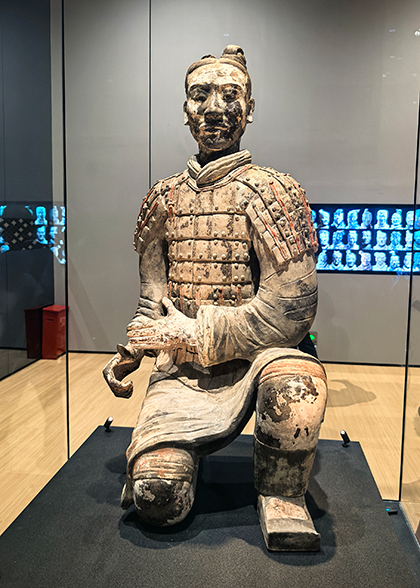
Since Sep. 8, 2024, the Emperor Qinshihuang's Mausoleum Site Museum has opened the exhibition, Archaeological Discoveries at the Mausoleum of Complex of China's First Emperor with 230 cultural treasures in eight categories on display for the first time, to celebrate the 50th Anniversary of the Archaeological Excavation of Terracotta Warriors and Horse.

Read details of the
Exhibition of Archaeological Discoveries there
Emperor Qinshihuang's Mausoleum Site Museum was built based on the Mausoleum of Emperor Qin Shi Huang, which was historically known as Lishan Garden and is the largest imperial tomb in China with the richest buried objects. In February, 2009, the local bureau of cultural heritage finally declared the establishment of the Museum. The site area retains the Museum of Terra-cotta Warriors and Horses of Qin Shi Huang and has built the Qin Shi Huang's Mausoleum Site Park (Lishan Garden) based on the discoveries from the mausoleum of the emperor.
As a part of Emperor Qinshihuang's Mausoleum Site Museum, the Museum of Terra-cotta Warriors and Horses is located 37 km (23 mi) east of Xi'an city. The pits of terra-cotta warriors and horses first discovered in 1974 were one of the biggest contemporary archeological discoveries. With large scale, great quantity, unsurpassed technique and artistic value, the museum has brightened every visitor’s eye since its opening. Every year, millions of visitors come here, including many heads of foreign states and governments. It is the most well-known name card of Xi'an City and the first temptation for visitors to enjoy in this city.
Qin Shi Huang's Mausoleum Site Park (Lishan Garden)
With an area of 226 hectares (about 558 acres), this site park of Emperor Qinshihuang's Mausoleum Site Museum was opened to the public on October 1, 2010. It contains the tumulus of
Qin Shi Huang Mausoleum, major architectural sites that have been discovered, ritual sacrifice pits, the Museum of Terracotta Acrobatics, Museum of Terracotta Civil Officials, Museum of Stone Armor and Museum of Bronze Chariot and Horse.
 |
A Terracotta Warrior of the Exhibition
of Archaeological Discoveries |
The site park means to protect the relics to the greatest extent as it laid over the past two thousand years. The archeologists have discovered the inner and outer wall of Qin Shi Huang’s tomb. The site is sealed by earth and the walls are marked on the ground by evergreen plants. Similar measures will be applied to other sites that have been discovered. The pit of Terracotta Civil Officials was first discovered in early 2000 in the southwest corner of the tumulus. Unlike other pits, this one wasn’t burnt. A small fraction of artifacts were excavated, including terra-cotta warriors, wooden chariot, weapons and horse skeletons. From the decorations worn on the warriors, the pit was defined as the pit of civil officials, resembling the department in charge of prison and justice in the Qin court. After mildew-proofing treatment, the backfill protection was conducted on the pits of Civil Officials and Terracotta Acrobatics. The museums built on the pits allow tourists to visit and view archaeological excavation at the same time. The underground palace is the core of Qin Shi Huang’s mausoleum. To answer the public concern if the underground palace would be opened, the curator of the site park once expressed his principles, protection and respect. Leave that exactly as it is, now and in the future, as we all hope there is one day that people can use advanced technology to see the underground clearly without disturbing the endless sleeping soul.
The site park is six times larger than the previous main reserved area. There are some 30 tourist buses shuttling on the 1.5 km (1 mi) highway between the Museum of Terra-cotta Warriors and Horses of Qin Shi Huang and Lishan Garden and battery vehicles inside the garden. In the square north to the tumulus, a 15-minute dance show will help you back to the Qin Empire. The through ticket includes all the museums, sites, bus and car rides. The tumulus in the open air is not allowed to climb.

Supplementary readings:
 Map of Emperor Qin Shi Huang's Mausoleum
Map of Emperor Qin Shi Huang's Mausoleum City Walls to Protect Qin Shi Huang Mausoleum
City Walls to Protect Qin Shi Huang Mausoleum Excavation of Qin Shi Huang Mausoleum
Excavation of Qin Shi Huang Mausoleum Hot Topics on Qin Shi Huang Mausoleum
Hot Topics on Qin Shi Huang Mausoleum How to Travel to the Emperor Qinshihuang's Mausoleum Site Museum
First you need to get to Terracotta Army (check
Transportation to the Museum of Terra-cotta Warriors and Horses). Then you can take a free shuttle bus at the exchange bus station on the opposite of Qinshihuang Statue to Emperor Qinshihuang's Mausoleum Site Museum, also Lishan Garden. As Lishan Garden is large, visiting on foot is pretty exhausting. It's recommended to take the battery sightseeing car at a cost of CNY 15.
 | | Entrance of Lishan Garden | |  | | Shuttle buses in the Site Park | |
| Through Ticket | CNY 120; free for children under 1.2m (3.9 feet); foreign students studying in China with valid student ID can enjoy half-price tickets.
The fare is for the Emperor Qinshihuang's Mausoleum Site Museum Through Ticket including the Museum of Qin Terracotta Warriors and Horses, Lishan Garden and shuttle buses inside the scenic area.
Note: Foreigners' passports will be required when booking tickets and entering the museum. |
| Opening Hours | March 16 to November 15: 08:30-18:30 (Ticket selling stops at 17:00.)
November 16 to next March 15: 08:30-18:00 (Ticket selling stops at 16:30.) |
Recommended
Time for a Visit | Three hours |
- Last updated on Nov. 15, 2024 by Gabby Li -




